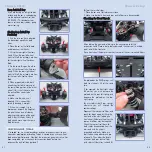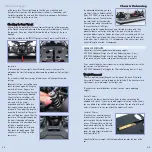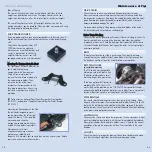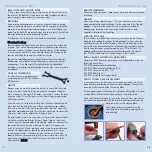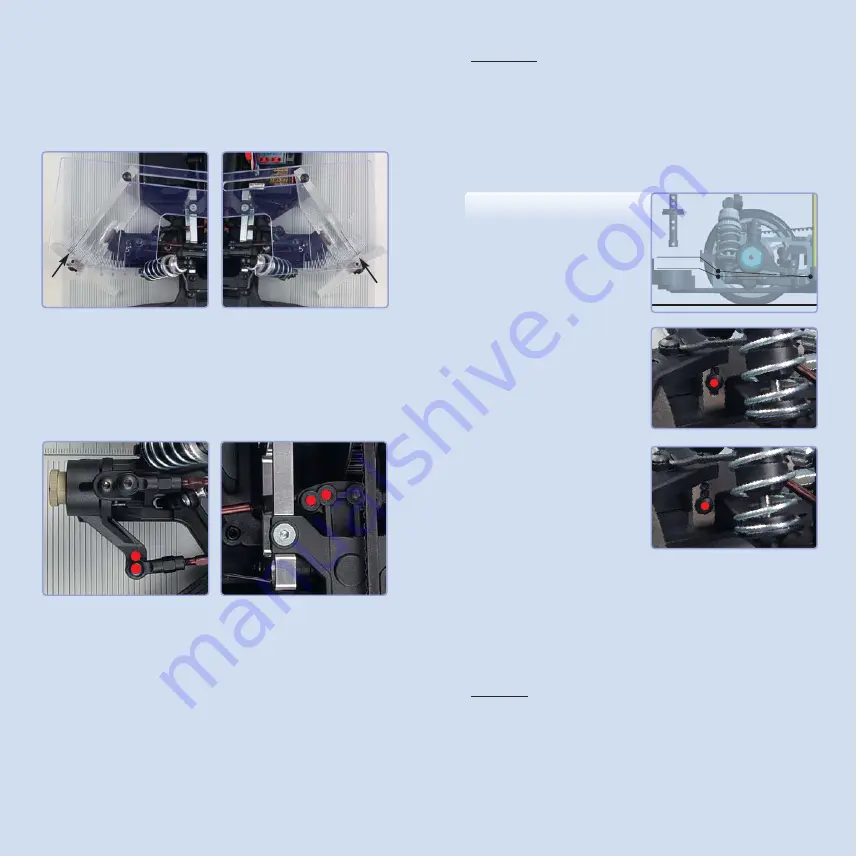
Initial Settings:
Servo saver: INNER inner holes (position #1)
Steering block: OUTER holes (position #2)
The initial Ackermann setting gives a comfortable driving feeling. However,
you can use the optional Ackermann positions on the servo saver if you want
a more aggressive steering feeling. Be aware that the car may be more
difficult to drive.
FRONT ANTI-DIVE
Front anti-dive refers to the angle at
which the front suspension is
mounted in relation to horizontal
when looked at from the side of the
car.
There are two possibilities for front
anti-dive:
•• U
Uppppeerr hhoollee ((33°° aannttii--ddiivvee))::
Works
well in bumpy conditions, due to
the constant caster angle when
the suspension is compressed.
However, steering is not as
responsive as the 0° anti-dive
setting.
•• LLoow
weerr hhoollee ((00°° aannttii--ddiivvee))::
Gives
more aggressive steering when
braking and especially while
cornering, due to a decrease in
caster when turning off-throttle.
NOTE: Only use the two lower holes
for front anti-dive. The front upper
hole is a production hole.
Front anti-dive is very easy to adjust. Loosen the four screws that mount the
front lower suspension pin holders. Then remove the two screws that hold
the FRONT pair of lower suspension holders, and pivot the front of the
lower arms up or down to align with the upper or lower front holes.
Replace the two screws and tighten all four screws. Check for freedom of
movement.
Initial Setting:
Front anti-dive: 3° (upper hole)
Note: The anti-dive setting impacts the caster setting. To get the true caster
setting, add the value of caster block to the front anti-dive value. For example,
if you have 3° caster block and set 3° anti-dive, the overall caster setting is 6°
caster.
Chassis Setup
When adjusting the steering servo, adjust the steering so the steering blocks
do not turn the maximum amount. If they do, decrease steering throw with
your transmitter's EPA setting, or dual-rate setting if EPA is not available.
The steering system is designed with the optimal Ackermann setting for a
touring car. However, you can use the optional Ackermann positions to fine-
tune your car’s steering.
C
Ch
ha
an
ng
giin
ng
g tth
he
e A
Acck
ke
errm
ma
an
nn
n S
Se
ettttiin
ng
g
Move the two steering rods to the outer holes on the servo saver. Note that
you must decrease the length of both the left and right steering rods by 5mm
each when you change to the outer holes on the servo saver, while keeping
the steering rods in the steering block outer holes.
Connecting the steering rods to the various holes on the servo saver and the
steering blocks gives the following steering characteristics:
SStteeeerriinngg bblloocckk IIN
NN
NEERR hhoolleess #
#11,, aanndd......
•• SSeerrvvoo ssaavveerr iinnnneerr hhoolleess #
#11:: Equal steering of wheels. Smooth and neutral
steering through the whole corner.
•• SSeerrvvoo ssaavveerr oouutteerr hhoolleess #
#22:: Different steering of wheels, inner wheel
closes in more. Steering into corner is smoother. Steering in mid-corner
and exiting corner is more aggressive.
SStteeeerriinngg bblloocckk O
OU
UTTEERR hhoolleess #
#22,, aanndd......
•• SSeerrvvoo ssaavveerr iinnnneerr hhoolleess #
#11:: Same as steering block INNER/servo saver
INNER (above), except effect is more exponential.
•• SSeerrvvoo ssaavveerr oouutteerr hhoolleess #
#22:: Same as steering block INNER/servo saver
OUTER (above), except effect is more exponential.
Chassis Setup
22
21
3° ANTI DIVE
0° ANTI DIVE
1
1
2
2
Summary of Contents for T1R Raycer
Page 1: ......

















